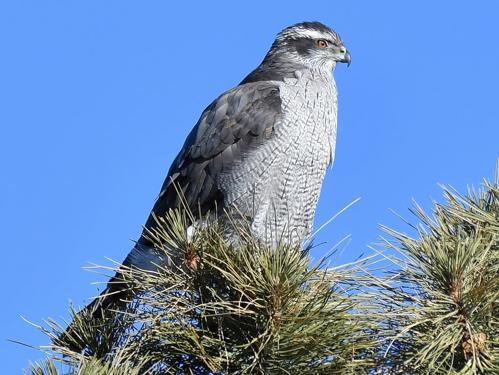Nature has been an eternal source of inspiration for human innovation and technological advancements. The intricate workings of the natural world often provide valuable insights that can be applied to various fields. One such example is the development of camera stabilization technology, which owes its origins to the remarkable flying abilities of the Northern Goshawk. In this blog, we delve into the fascinating connection between this majestic bird of prey and the evolution of camera stabilization, highlighting the impact it has had on the world of photography and videography.
The Northern Goshawk and Its Aerial Prowess:
The Northern Goshawk (Accipiter gentilis) is a formidable raptor known for its exceptional hunting skills and agility in flight. This bird possesses a unique adaptation called "forward flight stabilization." While flying through dense forests or challenging environments, the Northern Goshawk utilizes an intricate stabilization mechanism that allows it to maintain a steady gaze on its prey, even during high-speed maneuvers.
This is a video of a hawk, but the Goshawk takes it to the next level.


The Stabilization Mechanism:
The key to the Northern Goshawk's incredible stability lies in its ability to make micro-adjustments to its head and body posture in response to rapid changes in its surroundings. By modulating its wing and tail movements, the bird compensates for external disturbances, such as gusts of wind or obstacles in its flight path. These adjustments ensure that the bird's head remains consistently fixed on its target, regardless of its body movements.

Inspiration for Camera Stabilization:
Camera stabilization technology aims to replicate the Northern Goshawk's ability to maintain a stable gaze while capturing images or videos, especially in challenging conditions. The bird's capacity to compensate for external disturbances led to the development of mechanical and electronic stabilization techniques that minimize camera shake and vibrations. Let's explore some of the key advancements that have emerged from this avian inspiration.
-
Mechanical Image Stabilization:
Mechanical stabilization systems were the first to take inspiration from the Northern Goshawk. They employ gyroscopic sensors or movable internal components to counteract the effects of unwanted movements. By rapidly adjusting the position of the lens or image sensor, these mechanisms effectively compensate for vibrations or sudden jolts, resulting in sharper and more stable images.
-
Optical Image Stabilization (OIS):
Building upon the principles of mechanical stabilization, optical image stabilization (OIS) uses specialized lenses that can physically shift to counteract camera movements. These lenses are equipped with miniature electromechanical actuators that move the lens elements, allowing them to compensate for hand tremors or other vibrations. OIS has become a common feature in modern digital cameras and smartphones, significantly improving image quality, especially in low-light conditions.
-
Electronic Image Stabilization (EIS):
Electronic image stabilization (EIS) takes a different approach to camera stabilization by utilizing sensor data and software algorithms. Instead of relying on mechanical or optical components, EIS compensates for camera movements by digitally processing the captured frames. This technology analyzes the input from gyroscopic sensors or accelerometers to identify and correct unwanted motion. EIS is often used in action cameras and smartphones, providing smoother video footage by reducing shakiness and distortion.
-
Gimbal Stabilization:
The most advanced form of camera stabilization, known as gimbal stabilization, closely emulates the Northern Goshawk's ability to maintain a stable gaze while maneuvering through its surroundings. A gimbal is a pivoted support system that allows a camera to rotate smoothly on multiple axes while keeping it steady. This technology relies on brushless motors and sophisticated sensors to counteract movements in real-time, providing filmmakers and photographers with remarkably smooth and professional-looking shots.

Summary:
The Northern Goshawk's extraordinary ability to navigate complex environments and maintain a steady gaze on its target has served as a remarkable inspiration for camera stabilization technology. By studying the bird's flight patterns and adaptation, engineers and innovators have developed mechanical, optical, electronic, and gimbal stabilization techniques that have revolutionized the world of photography and videography.
Camera stabilization technology has empowered photographers and filmmakers to capture high-quality images and videos with unprecedented stability, even in challenging conditions. Whether it's capturing fast-paced action shots, shooting in low-light environments, or creating smooth cinematic footage, these advancements have significantly enhanced the quality and professionalism of visual content.
Moreover, the influence of the Northern Goshawk's stabilization mechanism extends beyond the realm of cameras. The principles derived from the bird's flight adaptation have found applications in various fields, including aerospace engineering, robotics, and even prosthetics. By mimicking the bird's ability to maintain stability and adapt to external disturbances, engineers have been able to develop innovative solutions that enhance performance and functionality.
As technology continues to advance, we can expect further refinements and improvements in camera stabilization techniques. The integration of artificial intelligence and machine learning algorithms, coupled with more advanced sensors, will likely result in even more precise and effective stabilization systems. This, in turn, will open up new creative possibilities and push the boundaries of visual storytelling.
In conclusion, the awe-inspiring flight abilities of the Northern Goshawk have provided invaluable inspiration for camera stabilization technology. By understanding and replicating the bird's stabilization mechanisms, engineers and innovators have made significant advancements in mechanical, optical, electronic, and gimbal stabilization techniques. These developments have revolutionized the field of photography and videography, enabling professionals and enthusiasts alike to capture stunning, stable imagery. As we continue to draw inspiration from nature's wonders, we can anticipate further breakthroughs that will shape the future of visual technology and its applications across various industries.
Discover More
Most Viewed
Christmas is a season of joy, love, and traditions. And what better way to get into the holiday spirit than through timeless carols? These musical gems have been bringing people together for generations. Here’s our ranked list of the Top 10 Christmas Caro…
Read More

















